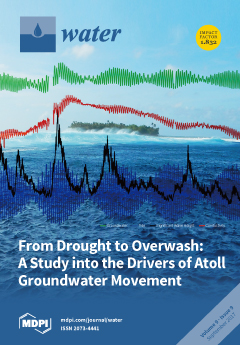In this study, the aim was to evaluate the adsorption capacity of a volcanic rock commonly used in Mexico as filter medium in constructed wetlands (locally named
tezontle) for carbamazepine (CBZ) adsorption, as well as to analyze the change in its capacity
[...] Read more.
In this study, the aim was to evaluate the adsorption capacity of a volcanic rock commonly used in Mexico as filter medium in constructed wetlands (locally named
tezontle) for carbamazepine (CBZ) adsorption, as well as to analyze the change in its capacity with biofilm growth. Adsorption essays were carried out under batch conditions by evaluating two particle sizes of
tezontle, two values of the solution pH, and two temperatures; from these essays, optimal conditions for carbamazepine adsorption were obtained. The optimal conditions (pH 8, 25 °C and 0.85–2.0 mm particle-size) were used to evaluate the adsorption capacity of
tezontle with biofilm, which was promoted through
tezontle exposition to wastewater in glass columns, for six months. The maximum adsorption capacity of clean
tezontle was 3.48 µg/g; while for the
tezontle with biofilm, the minimum value was 1.75 µg/g (after the second week) and the maximum, was 3.3 µg/g (after six months) with a clear tendency of increasing over time. The adsorption kinetic was fitted to a pseudo-second model for both
tezontle without biofilm and with biofilm, thus indicating a chemisorption process. On clean
tezontle, both acid active sites (AAS) and basic active sites (BAS) were found in 0.087 and 0.147 meq/g, respectively. The increase in the adsorption capacity of
tezontle with biofilm, along the time was correlated with a higher concentration of BAS, presumably from a greater development of biofilm. The presence of biofilm onto
tezontle surface was confirmed through FTIR and FE-SEM. These results confirm the essential role of filter media for pharmaceutical removal in constructed wetlands (CWs).
Full article





